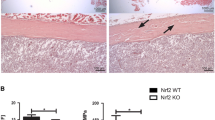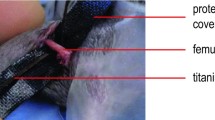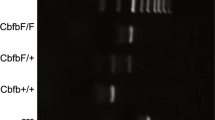Abstract
Tetranectin is a plasminogen-binding protein that enhances plasminogen activation, which has been suggested to play a role in tissue remodeling. Recently, we showed that tetranectin has a role in the wound-healing process. In this study, we investigated whether tetranectin plays a role in fracture healing. The fracture-healing process was studied using a femoral osteotomy model in tetranectin-null mice, previously generated by the authors. Radiographic imaging, micro-computed tomography (μCT), and histological analysis were used to evaluate osteotomy healing. In wild-type mice, a callus was apparent from 7 days, and most samples showed marked callus formation and rebridging of the cortices at the osteotomy site at 21 days. In contrast, in the tetranectin-null mice there was no callus formation at 7 days and much less callus formation and no bridging of cortices were observed at 21 days. At 35 days, all osteotomy sites showed clear rebridging, and secondary bone formation was achieved in wild-type mice by 42 days. In contrast, no clear rebridging or secondary bone formation was observed at 42 days in the tetranectin-null mice. Analysis using μCT at 21 days after osteotomy revealed that the callus area in tetranectin-null mice was smaller than that in wild-type mice. Histological analysis also showed that soft tissue and callus formation were smaller in the tetranectin-null mice at the early stage of the healing process after drill-hole injury. These results suggested that tetranectin could have a role in the positive regulation at the early stage of the fracture-healing process, which was reflected in the delayed fracture healing in tetranectin-deficient mice.







Similar content being viewed by others
References
Maes C, Coenegrachts L, Stockmans I, Daci E, Luttun A, Petryk A, Gopalakrishnan R, Moermans K, Smets N, Verfaillie CM, Carmeliet P, Bouillon R, Carmeliet G (2006) Placental growth factor mediates mesenchymal cell development, cartilage turnover, and bone remodeling during fracture repair. J Clin Invest 116:1230–1242
Gerstenfeld LC, Cullinane DM, Barnes GL, Graves DT, Einhorn TA (2003) Fracture healing as a post-natal developmental process: molecular, spatial, and temporal aspects of its regulation. J Cell Biochem 88:873–884
Colnot C, Thompson Z, Miclau T, Werb Z, Helms JA (2003) Altered fracture repair in the absence of MMP9. Development (Camb) 130:4123–4133
Gerstenfeld LC, Cho TJ, Kon T, Aizawa T, Cruceta J, Graves BD, Einhorn TA (2001) Impaired intramembranous bone formation during bone repair in the absence of tumor necrosis factor-alpha signaling. Cells Tissues Organs 169:285–294
Shimoaka T, Kamekura S, Chikuda H, Hoshi K, Chung UI, Akune T, Maruyama Z, Komori T, Matsumoto M, Ogawa W, Terauchi Y, Kadowaki T, Nakamura K, Kawaguchi H (2004) Impairment of bone healing by insulin receptor substrate-1 deficiency. J Biol Chem 279:15314–15322
Zhang X, Schwarz EM, Young DA, Puzas JE, Rosier RN, O’Keefe RJ (2002) Cyclooxygenase-2 regulates mesenchymal cell differentiation into the osteoblast lineage and is critically involved in bone repair. J Clin Invest 109:1405–1415
Kayal RA, Tsatsas D, Bauer MA et al (2007) Diminished bone formation during diabetic fracture healing is related to the premature resorption of cartilage associated with increased osteoclast activity. J Bone Miner Res 22:560–568
Gaston MS, Simpson AH (2007) Inhibition of fracture healing. J Bone Joint Surg Br 89:1553–1560
Wewer UM, Albrechtsen R (1992) Tetranectin, a plasminogen kringle 4-binding protein, cloning and gene expression pattern in human colon cancer. Lab Invest 67:253–262
Høgdall CK (1998) Human tetranectin: methodological and clinical studies. APMIS Suppl 86:7–31
Clemmensen I, Petersen LC, Kluft C (1986) Purification and characterization of a novel, oligomeric, plasminogen kringle 4 binding protein from human plasma: tetranectin. Eur J Biochem 156:327–333
Iba K, Durkin ME, Johnsen L, Hunziker E, Damgaard-Pedersen K, Zhang H, Engvall E, Albrechtsen R, Wewer UM (2001) Mice with a targeted deletion of the tetranectin gene exhibit a spinal deformity. Mol Cell Biol 21:7817–7825
Iba K, Hatakeyama N, Kojima T, Murata M, Matsumura T, Wewer UM, Wada T, Sawada N, Yamashita T (2009) Impaired cutaneous wound healing in mice lacking tetranectin. Wound Rep Regen 7:108–112
Martin P, Hopkinson-Wooley J, McCluskey J (1992) Growth factors and cutaneous wound repair. Prog Growth Factor Res 4:25–44
Clark RAF (1991) Cutaneous wound repair. In: Goldsmith LA (ed) Physiology, biochemistry, and molecular biology of the skin. Oxford University Press, New York, pp 576–601
Einhorn TA (1998) The cell and molecular biology of fracture healing. Clin Orthop Relat Res 355(Suppl):S7–S21
Yamaguchi T, Takada Y, Maruyama K, Shimoda K, Arai Y, Nango N, Kosaki N, Tkaishi H, Toyama Y, Matsuo K (2009) Fra-1/AP-1 impairs inflammatory responses and chondrogenesis in fracture healing. J Bone Miner Res 24:2056–2065
Wewer UM, Ibaraki K, Schjørring P, Durkin ME, Young MF, Albrechtsen R (1994) A potential role for tetranectin in mineralization during osteogenesis. J Cell Biol 127:1767–1775
Doyon AR, Ferries IK, Li J (2010) Glucocorticoid attenuates the anabolic effects of parathyroid hormone on fracture repair. Calcif Tissue Int 87:68–76
Tsuji K, Komori T, Noda M (2004) Aged mice require full transcription factor, Runx2/Cbfa1, gene dosage for cancellous bone regeneration after bone marrow ablation. J Bone Miner Res 19:1481–1489
Garrett IR, Gutierrez GE, Rossini G, Nyman J, McClukey B, Flores A, Mundy GR (2007) Locally delivered lovastatin nanoparticles enhance fracture healing in rats. J Orthop Res 25:1351–1357
Naik AA, Xie C, Zuscik MJ, Kingsley P, Schwarz EM, Awad H, Guldberg R, Drissi H, Puzas JE, Boyce B, Zhang X, O’Keefe RJ (2009) Reduced COX-2 expression in aged mice is associated with impaired fracture healing. J Bone Miner Res 24:251–264
Tokunaga A, Oya T, Ishii Y, Motomura H, Nakamura C, Ishizawa S, Fujimori T, Nabeshima Y, Umezawa A, Kanamori M, Kimura T, Sasahara M (2008) RDGF receptor-β is a potent regulator of mesenchymal stromal cell function. J Bone Miner Res 23:1519–1528
Larsen KH, Frederiksen CM, Burns JS, Abdallah BM, Kassem M (2010) Identifying a molecular phenotype for bone marrow stromal cells with in vivo bone-forming capacity. J Bone Miner Res 25:796–808
Einhorn TA (1995) Enhancement of fracture-healing. J Bone Joint Surg Am 77:940–956
Wang W, Nyman JS, Moss HE, Gutierrez G, Mundy GR, Yong X, Elefteriou F (2010) Local low-dose lovastatin delivery improves the bone-healing defect caused by loss of function in osteoblasts. J Bone Miner Res 25:1568–1667
Acknowledgments
The authors thank Mr. Chida and Mr. Murayama (Kureha Special Laboratory Co., Ltd., Iwaki, Japan) for their contributions and advice on μCT analysis. This work was partially supported by grants to K.I. from the Collaboration Center for Community and Industry, Sapporo Medical University.
Conflict of interest
The authors report no conflicting interests and have nothing to disclose. The authors alone are responsible for the content and writing of the paper.
Author information
Authors and Affiliations
Corresponding author
About this article
Cite this article
Iba, K., Abe, Y., Chikenji, T. et al. Delayed fracture healing in tetranectin-deficient mice. J Bone Miner Metab 31, 399–408 (2013). https://doi.org/10.1007/s00774-013-0436-y
Received:
Accepted:
Published:
Issue Date:
DOI: https://doi.org/10.1007/s00774-013-0436-y




